you don't stop and look around once in a while, you could miss it
I’m home from a spontaneous trip to the Hollywood Hills tonight. Went up there with my son, and we hiked around in the dark and took some cool photos of the city lights. It’s the kind of spontaneous trip that makes life quite interesting. The kind of trip that slows life down so you can look around.
Ferris’ philosophy, which he relates at the start and end of the film, is like the thesis statement for the Groundhog Day Project. For Groundhog Day. For Phil Connors. I think of my WWPCD? bracelet and the answer is simple—take whatever Ferris Bueller would do and shave off a little dickishness.
But, there are some other things to get out of the way on this, Day 7 with Ferris Bueller’s Day Off. The lost topics. i.e. the topics I could get to if I had more days. I mean, if I had another week or more with this movie, I could do an entire series of entries on German-American immigrant history in Chicago and how this film is a celebration of their contribution to America—you think it’s a coincidence that Ferris gets out of the way not five minutes into the film that he doesn’t condone fascism? Nope. As a German-American, he wants to assure us in the audience that he is not a Nazi or a Nazi sympathizer. It’s important.
(And, my crazy tangents impress even me sometimes.)
Still, it does suggest a potential horror in Ferris telling us “you can never go too far.”
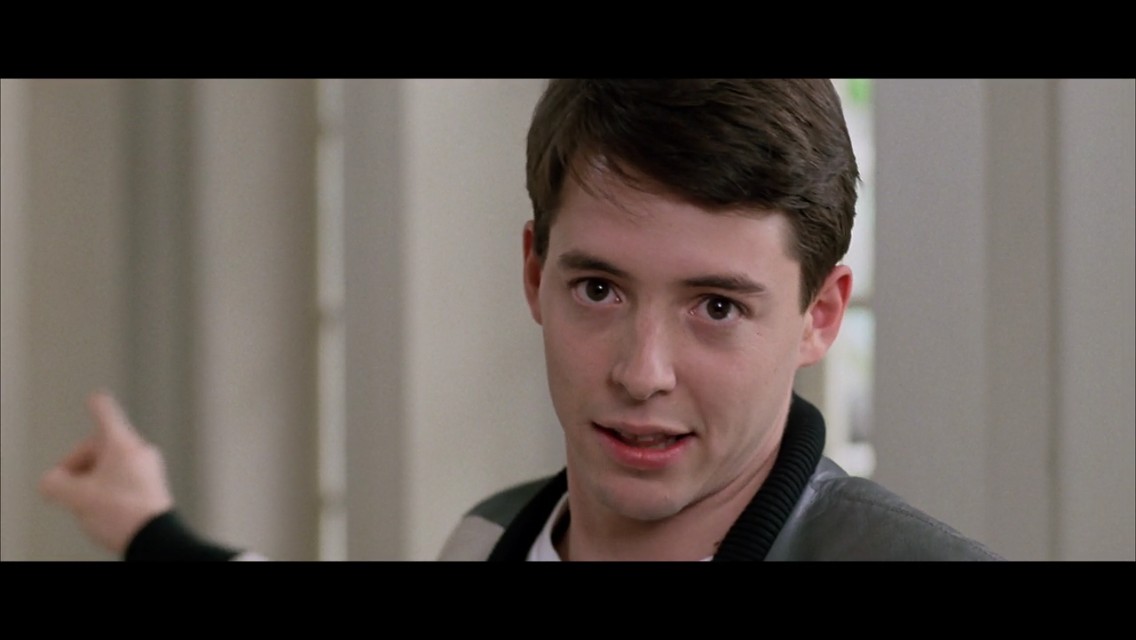
A minor topic would be how Katie Bueller hangs flyers on some rather nice framed photos by her desk. I mean, what does that say about her as a person? Nice framed photos of your coworkers and you stick ugly ol’ flyers on them? That’s just wrong.
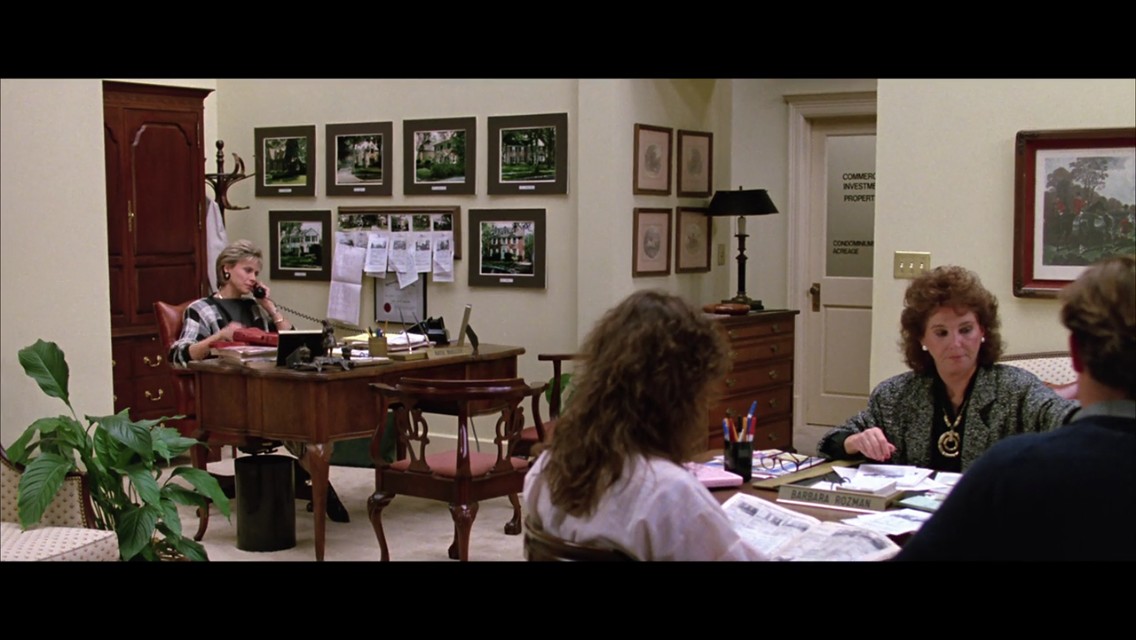
Another minor topic would be the personalized license plates. Morris Frye’s Ferrari, for example, bears the plate NRVOUS. Far more appropriate to Cameron than his father (probably). (And, there’s a whole other day’s entry worth of material in the fact that, apparently, they never used an actual Ferrari in the filmOther personalized plates: Tom Bueller’s car bears MMOM, reference to the film Mr. Mom, Katie Bueller’s car bears VCATION, reference to National Lampoon’s Vacation, and Jeannie’s car bears TBC, reference to The Breakfast Club. (By the way, today, March 24, is the 31st anniversary of the Saturday detention in that film.) All three of these films written by John Hughes. And, Rooney’s car, somewhat ironically, bears 4FBDO... FBDO for Ferris Bueller’s Day Off, and I’m guessing the 4 was because that car was sitting around just to Rooney could use it to chase after Ferris whenever he skipped school. What does that say about Rooney that he has a car just for that? Did he have a collection of cars like Morris Frye? Or just two—his everyday car and his Ferris Bueller’s Day Off car?
Another topic: filming locations, like I obsessed more than once with Groundhog Day last year—I think I may have obsessed a little extra once I knew I would be traveling to Woodstock, Illinois to see the locations in person. I don’t expect to be in Glenbrook or Chicago, Illinois anytime soon or I might obsess about finding Google Street View images of Cameron’s house or Ferris’ house... instead, I will just link you to a blog called Some Kind of Nostalgia, an entry about Shermer High School. And, I will note that I didn’t even catch until tonight that this was Shermer High School, the same fictional high school in The Breakfast Club.
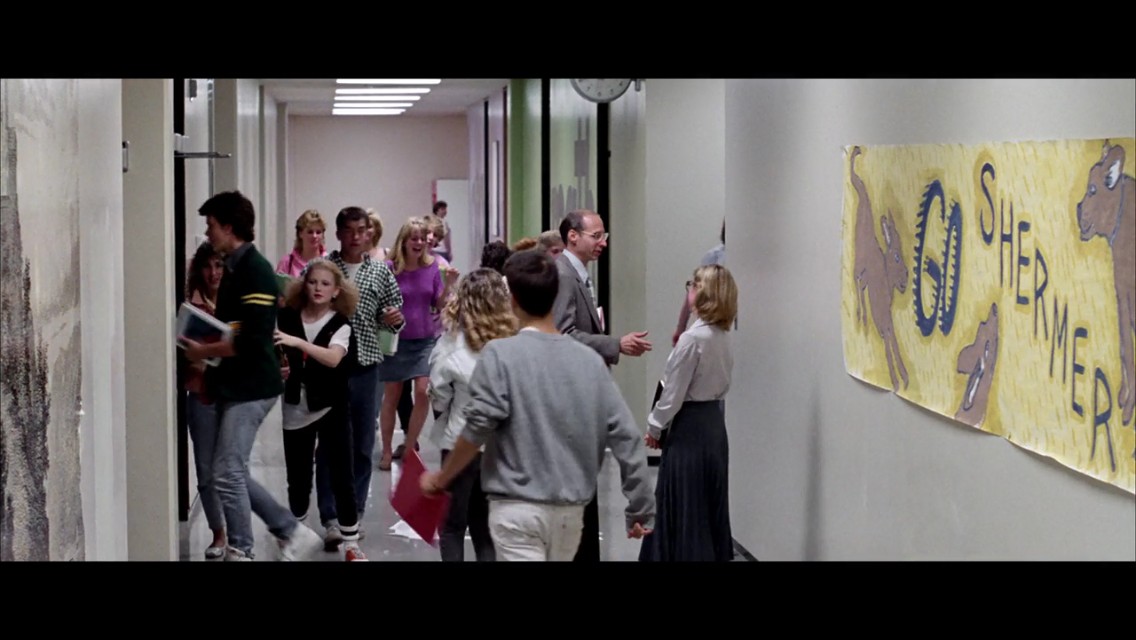
(In passing, I must say, because it has not seemed appropriate before now and would hardly justify its own topic—I am absolutely amused by how the guy collecting money to buy Ferris a new kidney calls Jeannie a “heartless wench.” There’s just something so random about that particular label in that particular situation; it makes me laugh every time.)
Another minor topic: is Cameron a hockey fan? Does he play hockey? Why does he wear that Gordie Howe Detroit Red Wings jersey?
A topic that just now came up: what are these hats (on the right)?
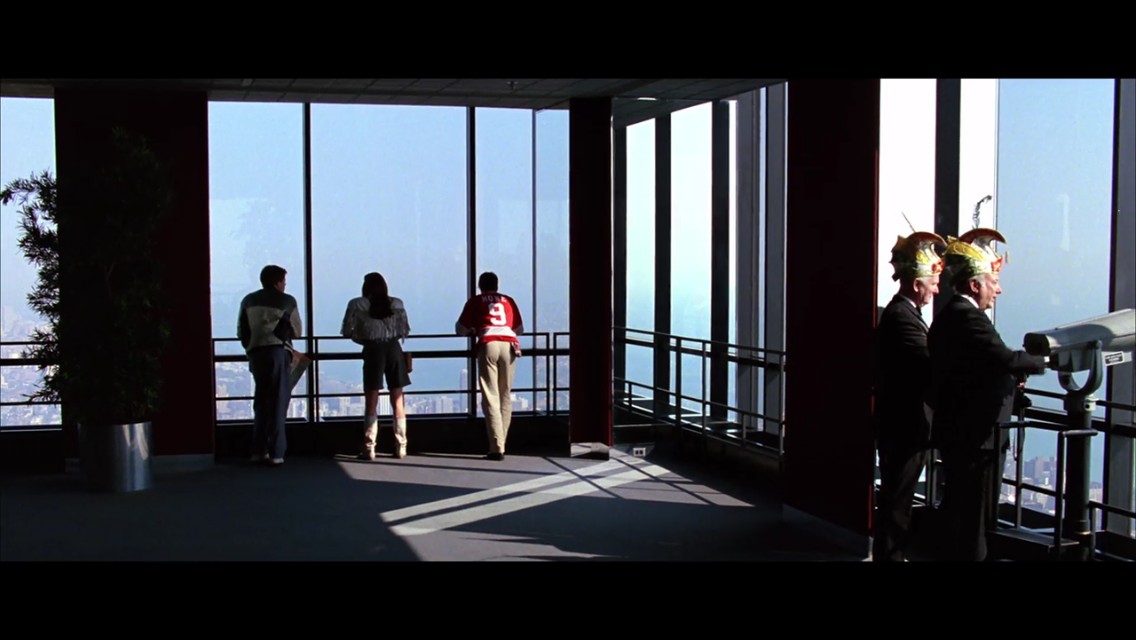
And, I’d love to catalog all the stuff in Ferris’ room, or look into the moves playing at that theater we see very briefly during the parade—
Creature (1985 film directed by William Malone) , Devil Within Her (which may be an old movie (even at the time) also known as Beyond the Door, directed by O. Hellman and R, Barrett, released in 1974) and Ninja Mission (which may be a 1984 film directed by Mats Helge)

—not that they connect in any way at all to this film or its story, or I could get into Ferris’ class schedule...

If you can’t read it, his schedule:
- MTWF - ENG COMP
- MWTF - CALCULUS
- TWTF - CHEMISTRY
- ALL - LUNCH
- MTWF - GYM
- TWTF - COMPUTER SC
- MWTF - UTOPIAN SCY
- MTWF - EURO HIST
A bit of a complicated schedule, three classes before and four after lunch. And, while they seem to alternate a bit Monday and Tuesday and Thursday, presumably with longer periods, he’s got all seven classes Wednesday and Friday. Someone pinpointed the day taking place in the film to June 5, 1985 based on the baseball game, nevermind that the Steuben Parade takes place in September or that Ferris’ grades on that computer screen suggest it is, in fact, the third trimester of school... actually, the grades don’t contradict the June date, but the temperature reported early in the film—a high in the upper 70s for the day. Which makes me wonder a) why Ferris was sitting outside in a bathing suit at like 8am and b) why those sunbathers are outside at all in their bikinis, let alone facing away from the sun. June 5, 1985 was a Wednesday, which includes European History, so Ferris could, indeed, have had a test on European Socialism that day.
The two things I find most interesting about Ferris’ schedule are 1) that he is not taking an economics class and 2) he’s taking Utopian Sociology. Ben Stein’s boring economics teacher was not a scripted thing, so whoever was in charge of making that records screen probably wouldn’t have known to include an ECON class. Ben Stein had no script for his lesson aside from the role call, but went with economics because he has a degree in that, and John Hughes told him to do so, of course. That Ferris is taking Utopian Sociology is, perhaps, an insight into Ferris’ character. That doesn’t sound like a required class but an elective, and a rather progressive/liberal-sounding class for mid-80s Middle America.
My own recent thoughts on “utopia” stem from a recent reading of Jose Esteban Munoz’ (2006) “Stages: Queers, Punks, and the Utopian Performative” which gets into the idea of performing utopia. Essentially, the world you want—you act that world out, you create that world through your actions. Which actually brings me back around to the topic I wanted to talk about today on this, Day 7 with Ferris Bueller’s Day Off. But, I’m already over 1300 words—I aim for at least 1000 each day in this blog, and usually surpass that goal—and the film is already nearly over—Jeannie is talking to Garth in the police station.
(Garth’s older brother is in jail, by the way. And, Ferris tells us (in the shooting script) that he (Ferris) is probably Garth’s only friend. Garth’s mother owns a gas station (check out the name on the tow truck)

and his father is dead. His sister is “rumored to be a prostitute.” (I wonder if she’s the nurse who likes to—) Garth cries himself to sleep every night, for no particular reason, or at least none that he could explain one night when Ferris spent the night. “The guy’s so conditioned to grief,” Ferris explains, “that if he doesn’t feel it, he can’t sleep.” Garth’s brother—the one in jail—is “a registered psycho” who once “ate a whole bowl of artificial fruit just so he could see what it was like to have his stomach pumped.” Charlie Sheen’s tired-eyed drug user/dealer is actually probably closer to Garth’s brother than Garth, even though in the script it’s Garth that Jeannie meets at the police station.)
There was one more lost topic to get into before a good long ramble about, you know, the meaning of life and stopping to “look around once in a while.” This is Day 7 with Ferris Bueller’s Day Off, but it is also Day 600 of the Groundhog Day Project. 365 days in a row with Groundhog Day and more than 60 other movies since, half of those for 7 days each. There’s still another film this month—this time we will remain inside Shermer High School instead of skipping out for the day...
But anyway, the other lost topic: the museum.
I’ve already talked about Cameron getting lost in that Seurat painting, twice. But, I wanted to bring up Picasso and Cubism. The latter actually relates to yesterday‘s entry about depression in that the various elements of Cameron’s, Sloane’s and Ferris’ time in the city is like the many angles of a Cubist painting on a single image. The day off works as a deconstruction of Cameron Frye, as it turns out, only to refocus him into something new in the end. Maybe I’m stretching, but we do see plenty of Picasso’s work in the film... “Nude under a Pine Tree,” “The Old Guitarist” and notably, three Cubist pieces lined up with our three main characters.

Sloane stands before “Seated Woman in a Red Armchair” (1931). This is a portrait of Marie-Therese Walter, Picasso’s mistress (until he got a new one) and mother of his daughter, Maya Widmaier-Picasso.
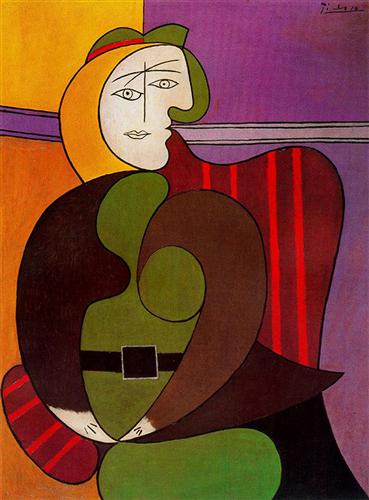
Ferris stands before “Portrait of Sylvette David” (1954). Lydia Sylvette David is an artist herself. She worked in a pottery studio near Picasso’s place and he liked the way she looked and created 40 works inspired by her. By the way, Picasso has a whole lot more works out there than I expected, even as obviously famous he was, even when alive.

Finding any information on the painting Cameron stands before was quite hard. The most I could find was that it was called “Seated Woman.” Picasso’s got a lot of Seated Women. I finally found it labeled as “Femme Assise” (1949) in a Sotheby’s auction in 2004. I don’t know who the subject of the painting is.

The Art of Film blog says, “Perhaps Hughes wanted... the characters to be seen observing these paintings because they visually represent some of the disjointed feelings felt by high school seniors.” (Nevermind that Sloane is not a senior, of course.) This is right after the three of them have all posed before, and like, Rodin’s “Portrait of Balzac.” Balzac, of course, wrote La Comedie Humaine, which, contrary to Picasso’s Cubism, is central to realism in European literature. Juxtaposing these pieces of art, these scenes, these characters—we are offered a Cubist Reality, a reality separate from reality. Ferris Bueller’s day off (and Ferris Bueller’s Day Off) offers us normal life twisted out of and away from its normalcy. Much like the original film that began this blog—Groundhog Day—Ferris Bueller’s Day Off shows us a trio of characters in a place that is not their usual stomping ground, and at least one of them is significantly changed. The weird thing is that Phil Connors is much more active in his own transformation than Cameron is in his. I don’t buy the theory going around that Ferris is just a figment of Cameron’s imagination—how do you explain, for example, Jeannie’s role in the film? Rooney’s? But, one could argue, especially in comparing this film to Groundhog Day, that Ferris Bueller is more like pre- or early-loop Phil Connors, late-in-the-day Cameron more like late- or post-loop Phil Connors. I’m not sure that Ferris Bueller learns anything from his day off. I’m not sure Ferris’ world has changed at all, really. Except inasmuch as, underneath his selfish exterior, Ferris actually does care about his friend and his friend is better off at the end of the day.
The museum scene ends quite deliberately. After all three characters pose as Balzac and then stare at Picasso paintings, after they have all had the opportunity to be contemplative, Ferris and Sloane retire to the darkened space by Chagall’s “America Windows” to kiss. They know who they are, and they want to be together. Cameron, though, has a little more to contemplate—staring at the Seurat painting—because he does not know who he is just yet. He’s still trapped in an idea of who Cameron Frye is, of who he is expected to be, of who he thinks he needs to be to (barely) survive.
And, that’s something we all face. Who we are expected to be, who we think we should be, who society and culture and family and friends tell us to be—these are not always the same person and are often not who we want to be. The hard part is figuring out how to navigate the sea of expectations while still maintaining some semblance of self, some semblance of agency.
The simple thing—whether performing utopia or simply navigating that sea of expectations—is a line from Tolstoy: “If you want to be happy, be.” On the one hand, it sounds like happiness is a choice. On the other hand, happiness comes from, well, just being. Being you. Being me. Making our own choices and acting toward our own interests and goals.
Life does move pretty fast. But, if you manage it well enough, it’s one hell of a ride. Don’t ever miss it, if you can help it.
Comments
Post a Comment